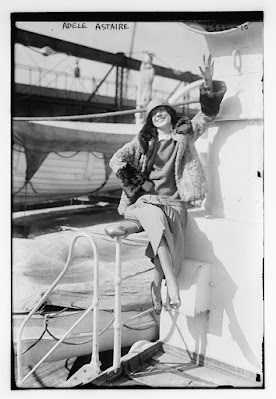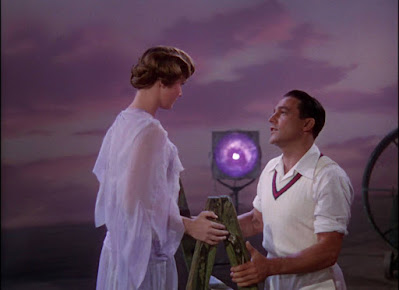Did the title make you do a double take?
Filmland Follies is named for a reason - I write about Old Hollywood, which typically sticks to movies. However, yesterday in a crossword I found a clue which I realized was more obscure than it should be. The clue was "sister of Fred Astaire." So I was inspired to write this blog post to celebrate said sister, who though she never followed her brother to Hollywood, deserves to be known further than the sphere of crossword-solvers who also love entertainment history.
 |
Adele on an ocean liner, mid-1920s.
|
So here is my little tribute to dancer, actress, singer, wartime volunteer, British peeress, and crossword puzzle answer - Adele Astaire. Adele Austerlitz was born in 1896 in Omaha, Nebraska to a German-American mother and an Austrian immigrant father. A year and half later, her brother Fred was born. Adele was enrolled in dancing school at an early age, and quickly showed talent and enthusiasm for dance. Fred was signed up after her, though in his autobiography he says he didn't really care about dancing at that point.
When Adele was eight, her mother moved the family to New York City. Adele, Fred, and their mother Ann here adopted a more American-sounding version of their surname Austerlitz, and became the Astaires. A year later, the siblings began a professional brother-and-sister vaudeville act. (This is something that mostly sounds exhausting but also tons of fun - or is that just me?) They performed occasionally and their mother home-schooled them while they had additional dance training.
Performing professionally at such a young age sounds crazy now, but child vaudeville acts were quite popular in the early 1900s. Think of little actors like Shirley Temple, who was already making films at the age of three!
Adele and Fred toured the country with their act, occasionally lying about their ages when laws were introduced stating vaudeville performers had to be fourteen. Adele was generally considered the more talented and popular of the two. Lively and vivacious, critics fawned over Adele and her theatrical prowess. "Heaven doesn't send every generation an Adele Astaire," one reviewer said.
 |
Little Fred and "Delly" in their vaudeville act, circa 1906.
|
The brother-and-sister act became better known over the years, and eventually Fred and Adele found their way to Broadway. Their first show, in 1917, was titled Over the Top. It was a revue-type show with lots of acts of all varieties. The siblings did partner dances and songs and the show was considered a success. After that they did The Passing Show of 1918, which was billed as "A HUGE WHIZZING ENTERTAINMENT!," and yes, in all capitals.
 |
As Adele's fame grew, she featured in
advertisements like this one. |
Adele nicknamed her brother "Moaning Minnie" for all the worrying he would do before shows. Where Fred would show up hours early to rehearse, "Delly" could run in minutes beforehand and perform just as well. Adele was popular in New York society and had many admirers which sometimes unnerved her brother. "My sister hardly ever lost her sense of humor," Fred said. She was beloved for her bubbly personality and wit, and personified the image of the 1920s flapper.
After the Passing Show, Fred and Adele began to earn larger roles. They did four more shows, Apple Blossoms (1919), The Love Letter (1921), For Goodness Sake (1922), and The Bunch and Judy (1922). Bunch and Judy was a flop and only ran for three and a half weeks. For a change of scenery, and to recover from the failed show, they brought For Goodness Sake to London in 1923. Retitled Stop Flirting, it was a smash hit with English audiences. The then-Prince of Wales, Edward VIII, came to the show one night. The cast was alerted the Prince would be there, and he arrived after the curtain went up. Adele heard this and said, "Well, good. What delayed him?"
Adele and Fred actually became close friends with both the Prince and his brother George VI. When the future Queen Elizabeth was born in 1926, the Astaires were invited to see the baby!
The siblings returned to New York a year later and starred in two more Broadway shows, Lady Be Good! and Funny Face. Again Adele was singled out for praise, both for her dancing and her skills as a comedienne. She was also an accomplished singer, with a high, warbly soprano voice. She was one of the most well-known stars on either side of the Atlantic at this point in her career. Unfortunately there aren't any recordings of the Astaires dancing together, but some of their songs are available on YouTube and quite worth listening to.
Funny Face went to London after its New York run and was again a huge hit. On the closing night of the London run, the Astaires were visited backstage by Lord Charles Cavendish, the second son of the 9th Duke of Devonshire. (Lots of numbers and titles, I know. To simplify, Charles was a British lord but not as important as a first son.) Delly and Charles saw a lot of each other while in Europe, and he came to New York to work as a banker. Fred and Adele returned to America as well, and opened in Smiles, which was unsuccessful.
 |
| Adele and Charles on their wedding day |
In 1931 the siblings made a comeback from their flop with the Band Wagon. With this show Adele planned to retire from the stage, and wanted to do so while her career was at a peak. Adele and Charles had fallen in love and were engaged. There are many things about this which I love:
1. Adele proposed to Charles.
2. She did so at a Prohibition speakeasy called 21.
3. After Adele retired from the stage, she was introduced to her future aristocratic relatives. She was formally announced, entered the room quietly, and then did cartwheels across the room until she got to the Cavendish family.
She sounds like she was a lot of fun to know.
The couple was married on May 9, 1932, and moved to Lismore Castle in Ireland. Sadly Adele had a difficult home life. Her husband Charles struggled with an alcohol addiction, and her three children did not survive. During World War II, she devoted herself to the war effort, working daily at the Red Cross's Rainbow Corner canteen in London. She wrote letters home for soldiers - up to 130 a week - worked in information, danced with the soldiers, and helped them with shopping. The volunteer work helped her through the hardships she was facing personally.
Around this time Adele received numerous offers to appear in stage shows and even films, but these were either turned down or dropped when screen tests did not turn out as she liked. How interesting would it have been to see her in Dark Victory, which ultimately starred Bette Davis? Or Annie Get Your Gun, for which she was originally considered?
After his long struggle with alcoholism, Lord Charles passed away in 1944. Adele remarried in 1947 to Kingman Douglass, an American banker whom she had met during the war. They split their time between New York, Virginia, Lismore Castle, and Jamaica until he died in 1971.
Adele was active and lively until her death at the age of 84 in 1981.
In summary, Adele is an immensely interesting personality and someone we all ought to know about. I think the general lack of knowledge about her career is due to the fact that no video recordings of her exist. But now you know! Hopefully I could shed some light on the wonder that was Adele Astaire, darling of Broadway and the West End and icon of the 20th-century stage.
Thanks for reading, and make sure to tell me what you thought!








Love listening to Fred and Adele singing together . At least we have audio recordings of them.
ReplyDeleteMe too - and it's lucky those recordings survived, given how long ago the performances were!
DeleteNicely written article about Adele Astaire! I thoroughly enjoyed it! It would have been nice to have seen her continue her career and do motion pictures with her brother Fred and by herself, especially since there is no footage of her Broadway performances available. I never heard her sing. I'll have to check out YouTube for her.
ReplyDelete